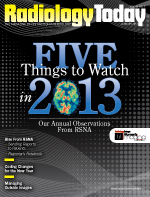 January 2013
January 2013
Direct Image Transfer — How a Trauma Center Improved Its Handling of Outside Images
By David Yeager
Radiology Today
Vol. 14 No. 1 P. 4
Along with adding significant cost to healthcare services, repeat imaging often exposes patients to unnecessary radiation and slows patient care. But imaging studies often are a critical component of healthcare delivery, which is one reason that digital image exchange recently has come to the forefront of the healthcare community’s consciousness. If their images aren’t readily available, patients treated by multiple doctors may be imaged several times. If the patient needs to be transferred between facilities, such as from a community hospital to a regional trauma center, the likelihood of repeat imaging rises.
A level 1 trauma center is a challenging environment for image exchange. Patients frequently arrive from referring hospitals, but it isn’t guaranteed that they will have their images with them. Complicating matters, the patients who do arrive with their images may have CDs that are in a proprietary format or, in some cases, may have their images on film. And CDs can be difficult to track during the chaos of an emergency situation. As CD volumes grew over time, Harborview Medical Center (HMC) in Seattle found them to be increasingly problematic.
“Surgeons, particularly orthopedic surgeons and neurosurgeons, could only really look at the images if they had physical access to that CD. And often these people are in the operating room, in the clinic, or in their office,” says Martin L. Gunn, MBChB, an associate professor of radiology at the University of Washington. “We have many of them who want to look at it at the same time at different places in the hospital, and they just couldn’t do that.”
HMC is the only level 1 trauma center for the states of Alaska, Idaho, Montana, and Washington—roughly 25% of the land area of the United States. It receives about 3,300 transferred trauma patients from outside acute care facilities each year. Because time is the enemy in trauma cases, patients often underwent repeat imaging to expedite clinical assessments and, when necessary, plan for surgery. In 2005, HMC decided to reengineer its image exchange workflow.
The Direct Approach
HMC’s staff began by identifying two important groups of outside facilities. One group consisted of busy outside facilities that were sending a large number of patients to HMC. The other group consisted of outside facilities that were sending CDs in proprietary formats that were incompatible with HMC’s PACS network.
HMC offered both groups the opportunity to send images via a virtual private network link to HMC’s PACS network. Many facilities accepted the offer, and HMC signed agreements of understanding related to patient privacy and continuity of care with those facilities. HMC also communicated a set of standards to those facilities regarding what would be considered acceptable imaging quality. By 2008, more than 120 facilities were linked to HMC; the current number is around 140.
For those facilities that declined to participate, HMC invested in conversion software so it could upload troublesome CDs to PACS as soon as the patients arrived. Making everything available on PACS allowed multiple users to view images concurrently, saving valuable time. To quantify the effects of the new workflow changes, HMC undertook a study that was published in the September 2012 issue of the Journal of the American College of Radiology. In the study, Gunn and his colleagues demonstrated that the combination of direct digital image transfers and uploading CDs and films to PACS reduced repeat imaging, decreasing patients’ radiation exposure and lowering costs.
The researchers identified 500 consecutive trauma patients who were transferred to HMC from an outside institution between June 1 and July 15, 2009. Of those patients, nine were classified as nonacute transfers and excluded from the study. Overall, the 491 study participants were imaged at a high rate, with only 71 (14%) receiving no imaging either at the outside facility or in HMC’s emergency department. Of the remaining 420 patients who received either radiography or CT or both, 383 (91%) had their exams imported into HMC’s PACS. Among other findings, the study determined that 8.1% of all CT exams were repeated, and the repeat CTs were performed on 17% of patients whose exams were uploaded. Those numbers are far below rates reported in other studies.
Gunn says HMC is pleased with the new workflow and is trying to streamline it further by eliminating the use of CDs to the greatest extent possible, although there will always be some CD use.
Outside Issues
With a constant flow of studies streaming into HMC’s PACS network, the new workflow has raised some new questions for the trauma center. Specifically, the organization is still trying to ascertain its medico-legal responsibilities for the outside studies and accompanying reports as well as to determine how to handle discrepancies in reports between outside radiologists and HMC’s radiologists.
Gunn says more studies are needed to fully explore the effects of direct image transfer and immediate uploading of medical images to facilities’ PACS, but he believes other trauma centers can benefit from HMC’s experience. For one thing, he says the system is relatively inexpensive to implement. For another, it’s easier to set up than it may seem at first glance.
“People often say this can’t be done because [the United States has] a very fragmented healthcare network,” Gunn says. “In fact, if you do talk to the outside facilities, people actually are very willing to share images of patients for the good of patient care, and I think that’s a good lesson.”
— David Yeager is a freelance writer and editor based in Royersford, Pennsylvania. He covers imaging informatics topics for Radiology Today.

